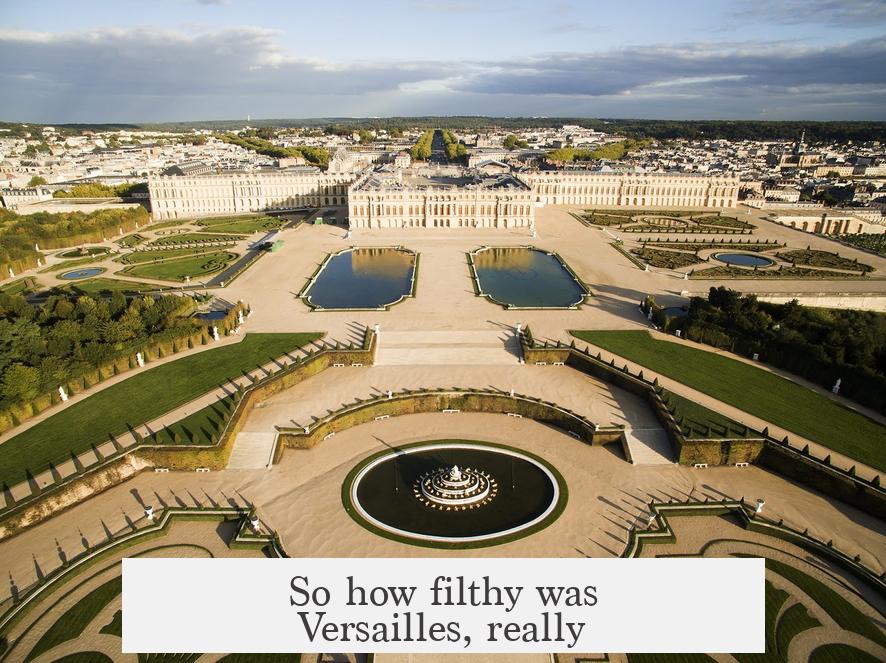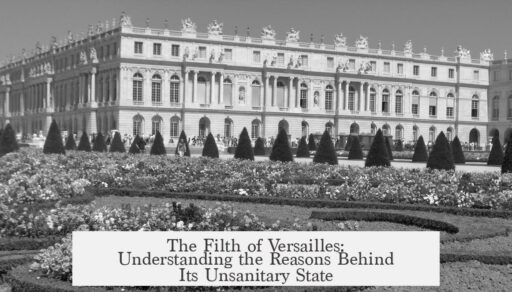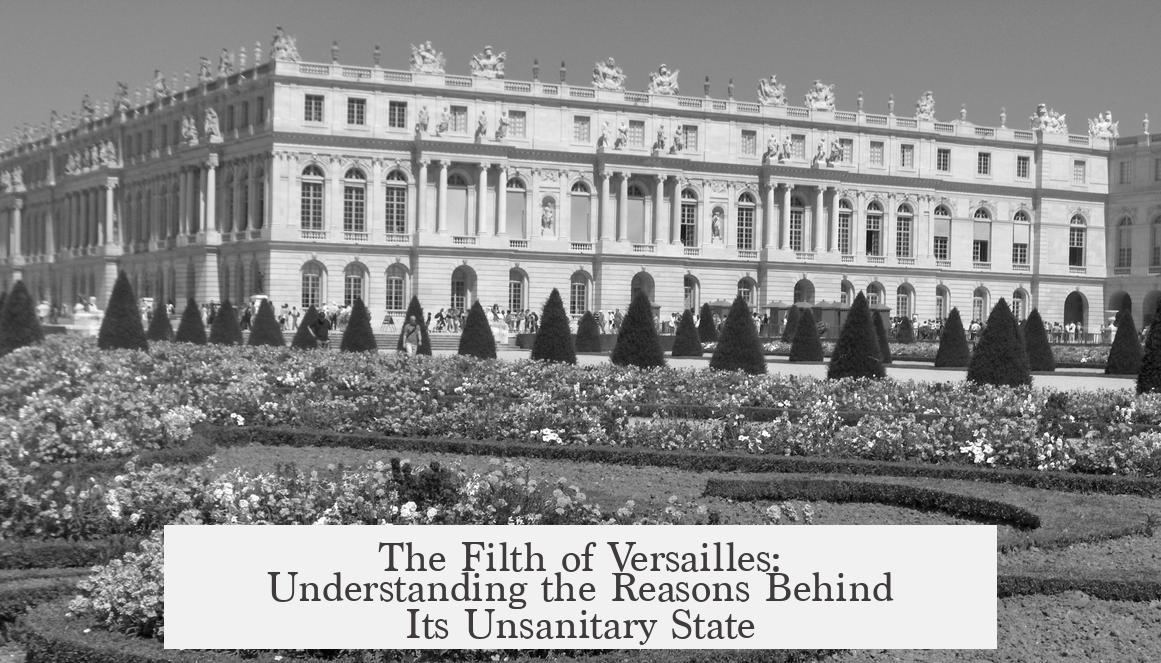Versailles was notably filthy by modern standards due to inadequate sewage and sanitation systems but aligned with 17th- and 18th-century hygiene norms. The palace relied on chamber pots and buckets without flush toilets, and smoky interiors and infrequent bathing contributed to unpleasant smells. However, frequent renovations improved facilities, and many negative depictions are often exaggerated myths tied to political biases after the French Revolution.
Versailles began construction around 1664 and expanded until 1710 in a small rural village. It lacked any existing sewer system, so builders could not install modern sewage infrastructure. Instead, residents used chamber pots, buckets, and furniture with built-in waste receptacles. Servants regularly emptied these containers, maintaining a basic level of cleanliness despite no efficient disposal system.
Compared to today’s sanitation standards, the palace was filthy. The absence of flush toilets left human waste stored inside rooms temporarily. Remodeling over time created chimneys that poorly vented smoke, so interiors became smoky and sooty. Bathing practices were infrequent, so body odor was more common. These conditions were normal, as hygiene standards differed greatly from current expectations.
Historical hygiene was shaped by limited knowledge of germ theory and technology. What is considered unhygienic now may have seemed acceptable or clean then. Some popular rumors claiming Versailles was overwhelmed with ‘piles of excrement’ in corners reflect prejudiced post-Revolution propaganda rather than facts.
After the monarchy collapsed, political opponents aimed to discredit royal lifestyles. Stories about nobles carelessly soiling their palaces drove a narrative of decadence and moral decay. However, accounts show the palace’s sanitation facilities underwent modernization during renovations, contradicting such crude depictions.
One primary source comes from Princess Palatine’s letters. She reports in 1694 that some outlying court residences had no lavatories, forcing inconvenient outdoor relief. These practical challenges existed but were mostly limited to peripheral estates, not the main palace complex.
Indoor sanitation was a low priority across European courts at the time. Public urination was widespread; for example, Frederick the Great’s Sans Souci Palace displayed signs banning urination in certain areas. At Versailles in 1762, kitchen boys were known to urinate near noble bedrooms, causing complaints and even breaking windows when confronted.
Latrines themselves posed problems. In 1785, one privy near seven rooms became so malodorous that occupants complained about the smell permeating their spaces and attracting undesirable visitors. This incident illustrates how adding facilities alone did not guarantee sanitary conditions under those era’s limitations.
Daily practices and clothing choices also intertwined with hygiene customs. Large skirts worn by women allowed discreet relief mechanisms without exposing themselves publicly, a practical adaptation rather than mere fashion.
| Factor | Description |
|---|---|
| Sewage Infrastructure | Absent; no modern sewers; use of chamber pots and buckets |
| Sanitation Practices | Servants emptied waste; rudimentary upkeep |
| Interior Conditions | Smoky, sooty due to poor chimney ventilation |
| Bathing Habits | Infrequent bathing led to body odor |
| Public Urination | Common and sometimes sanctioned; complaints recorded |
| Complaints & Renovations | Occasional odor issues; palace modernized in stages |
Versailles’ filth was typical for its time, not a sign of singular neglect or decadence. Negative portrayals often derive from stereotypes and political motives targeting the ancien régime. Modern hygiene improvements and infrastructure evolution render the palace’s past cleanliness unacceptable today but historically comprehensible.
- Versailles lacked efficient sewage, relying on chamber pots and servants for waste removal.
- The palace was smoky and smelled due to poor ventilation and infrequent bathing.
- Sanitation levels matched 17th-18th century norms, not modern standards.
- Post-Revolution rumors exaggerate filth for political reasons.
- Contemporary accounts show some sanitation challenges, mainly outside main palace.
- Public urination and foul latrines were common complaints in Versailles and Europe.
- Renovations improved facilities, but limitations of the era persisted.
How filthy was Versailles? Why was it allowed to be so?

Versailles was pretty filthy by today’s standards, but it wasn’t some unbearable horror show. The palace’s grime came from the limits of 17th-18th century technology and hygiene norms, not sheer neglect or decadence. Let’s unwrap how dirty Versailles really was and why it stayed that way.
First, keep in mind that Versailles was built starting around 1664 on a rural village site with minimal existing sanitation infrastructure. No modern sewer lines, no flush toilets. Simply put, the palace was ahead of its time in grandeur but not in plumbing. People relied heavily on chamber pots, buckets, and ornate chairs with hidden containers. These were emptied by legions of servants, so waste was managed—but not whisked away in a hygienic, odor-free way like today. The absence of efficient sewage systems was standard back then, so it can’t be singled out as a Versailles-specific scandal.
Would people living there have considered it dirty? Probably not. They were accustomed to the smells and smells. Bathing was infrequent, and so were changes of clothing. The palace interiors could become rather smoky and sooty over time. Chimneys didn’t always do their jobs right. Imagine lighting up a dozen candles and fireplaces every evening, in a room without modern ventilation. The air got thick and stinky, though not unbearable to them. Cleanliness standards then were a far cry from ours now.
Now, if you’ve ever heard wild tales—like nobles openly “shitting all over the floor” or piles of waste left in corners—don’t believe the hype. Many such stories stem from post-French Revolution propaganda. After the monarchy fell, revolutionaries and critics painted Versailles as decadent and disgustingly filthy to emphasize its moral bankruptcy. Rumors of overflowing chamber pots and squalid living conditions served political aims. Historical research has since debunked these myths. The palace had ongoing renovations and was outfitted with the best sanitation facilities available at the time.
One fascinating primary source comes from the Princess Palatine, who lived in the orbit of Louis XIV’s court and corresponded about daily life. She recounts frank struggles with sanitation, like in her 1694 letter complaining about having to “keep my pile of fecal matter until night” because her residence lacked proper toilets. This glimpse reveals that outlying houses connected to the court could lack facilities, but the main palace had more attention—and likely better arrangements.
Indoor sanitation barely ranked as a priority back then, even at royal courts. Public urination was fairly common in all of Europe, not just France. Frederick the Great of Prussia, for example, had to post signs at Sans Souci Palace forbidding urination in certain spots. At Versailles in 1762, the comte de Compans famously complained about kitchen boys relieving themselves near his bedroom—and in frustration, the boys smashed his windows. Those were different social rules and a looser relationship with ‘public decency’ than today.
Adding latrines or more bathrooms wasn’t a simple fix either. Some privies at Versailles became notorious for smelling so foul that nearby residents filed formal complaints. In 1785, seven tenants objected that a particular privy’s stench “penetrates the lodgings… and infects furnishing, clothes, and linen,” aside from attracting “riffraff” loitering about. So even with facilities, problems remained—partly from the limits of sanitation tech and partly from multiple users and close quarters living.
A curious bit here: women’s large skirts served a practical purpose beyond fashion. My humanities professor explained that the wide dresses allowed women to relieve themselves with some privacy and without “indecently exposing” themselves on palace floors or outdoors. Key takeaway? Sanitation, privacy, and modesty were important but handled differently than today.
Why was so much filth “allowed”?

The short answer: no one thought it was filthy, given their standards. The 17th and 18th centuries lacked modern microbiology and understanding of germs. Plus, no one had flush toilets or sophisticated waste disposal. Buildings weren’t well ventilated, and bathing norms differed. Servants performed regular cleaning duties.
Put another way, we judge Versailles by modern hygiene standards, which is like judging a horse and carriage by Formula 1 rules. It simply wasn’t possible to achieve sparkling cleanliness back then in such a massive complex hosting hundreds daily. And the court focused its resources primarily on appearances, ceremony, and prestige, not indoor plumbing perfection.
Besides, many hygiene norms were culturally accepted. Public urination, smoky rooms, scent of body odors—they were common across Europe. While we might shudder at the idea now, people then had different noses and standards. They likely considered Versailles “clean” compared to villages or urban slums.
So how filthy was Versailles, really?

- By today’s standards: quite filthy. No flush toilets, smoky rooms, limited bathing.
- By their own standards: relatively clean and orderly, with regular cleaning and sanitation attempts.
- Rumors of extreme filth often exaggerated due to political bias after the Revolution.
- Sanitation was a problem mainly on palace outskirts, not the core royal apartments.
- Public urination and foul smells were common courtwide in Europe, not Versailles alone.
All this helps explain why the palace had its share of hygiene shortcomings but was never the unhygienic cesspool some myths claim.
What lessons can modern readers take away?
Understanding historical context helps avoid harsh, anachronistic judgments. Hygiene standards evolve, just like fashion or politics. What seems revolting now was perfectly normal then. This insight prompts curiosity rather than scorn. It also highlights how far our sanitation systems have come—and how much we rely on unseen engineering to maintain health without thinking much about it.
Moreover, it reminds us that rumors and stories, especially about controversial regimes, often carry layers of political or social bias. Versailles became a symbol for excess and downfall, thus absorbing exaggerated tales of filth to tarnish its image further.
In sum, Versailles’s dirtiness was a product of its time’s technological limits and cultural norms—not laziness or decadence. While it wasn’t spotless, the palace was kept as clean as possible within the period’s means. Servants busied themselves with endless chamber pot emptying and soot scrubbing. That their courts could smell smoky or musty reflects more on early modern engineering than royal neglect.
So next time you imagine old Versailles, picture a grand palace filled with people begrudgingly dealing with smoky air, stinky latrines, and overflowing buckets—hardly the nightmare some have painted, but certainly far from the sanitized places we visit today!




